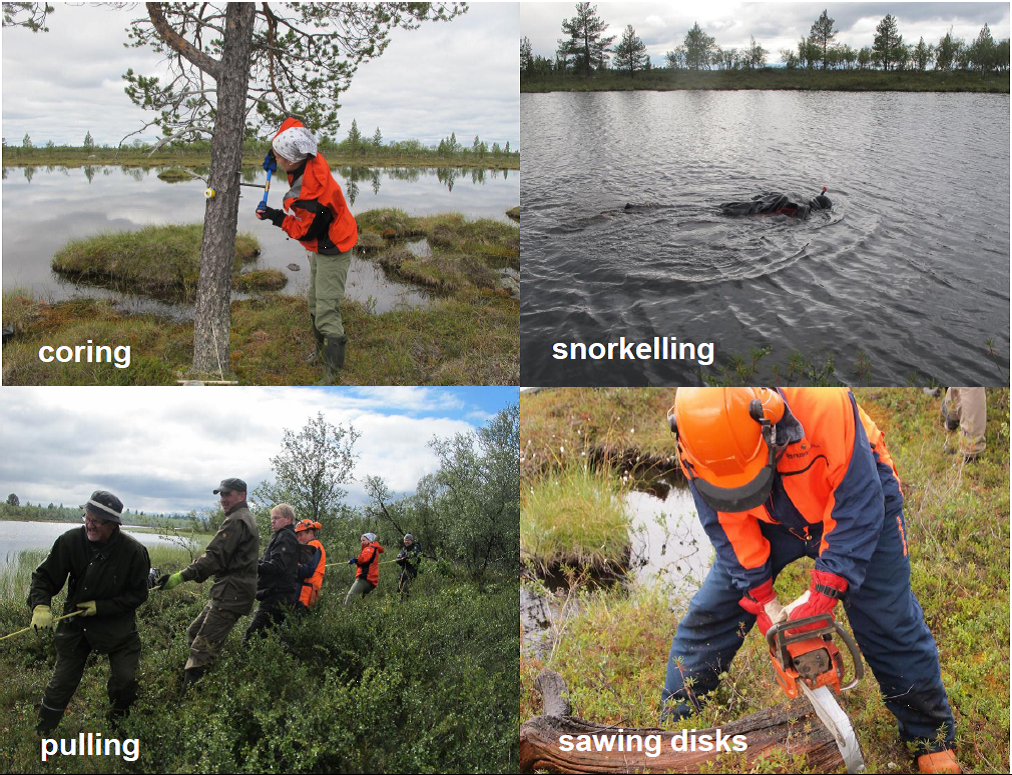CARATE – tree-ring carbon isotopes tell stories of past climate evolution
Markku Oinonen, docent, laboratory manager & Laura Arppe, post doctoral researcher
Trees are wonderful beings with a long memory – especially when it comes to the climatic conditions they experience. We take advantage of this particular characteristic of trees within the CARATE project, a research consortium between Laboratory of Chronology and the Finnish Forest Research Institute METLA (Oinonen & Mielikäinen, 2011). The project aims to produce a 7500-year record of climate and tree response to climate forcing in Northern Finland on the basis of the carbon isotope composition of cellulose in tree rings. Subfossil pine trees, preserved for thousands of years in the inoxic mud layers of some lakes in Finnish Lapland make possible the construction of multimillenial timeseries of climate, which can be dated precisely at annual resolution. The project relies on an existing supra-long collection of pinewood (Pinus sylvestris) material, complemented with recently collected specimens, covering the mid and late Holocene times continuously through the millennia since 5634 BCE until the present-day (Eronen et al. 2002; Helama et al., 2008). The dating of the uplifted pine trunks is determined via dendrochronological crossdating, after which the annual growth rings are sampled and processed to cellulose. The stable (non-radioactive) isotopic composition of carbon, δ13C, of the cellulose reflects photosynthetic production and has a strong correlation to growing season temperature (Hilasvuori et al., 2009).

The climate of Northern Lapland is characteristically sensitive to change in the North Atlantic variability because of its location immediately downwind of the Atlantic Ocean. Thus the produced time series are meaningful not only as local archives of climate history, but as records of regional climate evolution in the North Atlantic realm. In addition to studying the mid- to late-Holocene development of climate, the project focuses on more abrupt, short term climatic events related to volcanic eruptions. One such prominent case is the cold climate anomaly of 536 AD, observed as record low radial growth and frost damage in tree ring archives across the northern hemisphere. The climate data produced in the project will also serve as a point of reference for archaeological studies viewing human-climate interactions.
Eronen M., Zetterberg P., Briffa K.R., Lindholm M., Meriläinen J., Timonen M., 2002. The supra-long Scots pine tree-ring record for Finnish Lapland: Part 1, Chronology construction and initial inferences. The Holocene 12, 673–680.
Helama S., Mielikäinen K., Timonen M., Eronen M., 2008. Finnish supra-long tree-ring chronology extended to 5634 BC. Norwegian Journal of Geography 62, 271–277.
Hilasvuori E., Berninger F., Sonninen E., Tuomenvirta H., Jungner H., 2009. Stability of climate signal in carbon and oxygen isotope records and ring width from Scots pine (Pinus sylvestris L.) in Finland. Journal of Quaternary Science 24, 469–480.
Oinonen M & Mielikäinen K 2011. Muinaisympäristöjen kasvifysiologia: keski- ja myöhäis-holoseenikautisten puiden vuosilustojen kasvu- ja hiilen isotooppitietojen fuusioiminen (CARATE). Funding decisions #251287 and 251441 for CARATE project by the Academy of Finland.